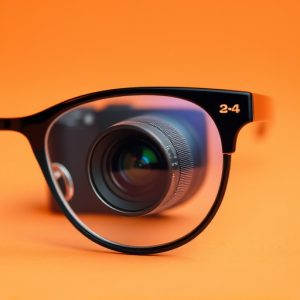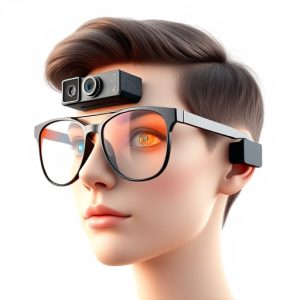Seeing the Future: The Evolution and Implications of Glasses with Built-in Cameras
Smart glasses with integrated cameras have revolutionized personal technology, offering functions fr…….
Smart glasses with integrated cameras have revolutionized personal technology, offering functions from capturing life's moments to augmented reality applications. These devices are not only transforming daily experiences for professionals like athletes and journalists but also hold the potential to innovate education and healthcare through AR. As they become more advanced, these smart eyewear pieces are becoming integral in a connected world, serving as interfaces between our physical surroundings and digital realms. The fusion of technology with fashion in the design of these glasses ensures they remain stylish while maintaining their smart capabilities. However, the rise of such devices raises significant privacy and security concerns that necessitate immediate attention from manufacturers and policymakers to ensure user data is protected and individual rights are upheld. This includes developing comprehensive guidelines for camera use, robust encryption for data protection, and transparent privacy settings. The responsible evolution of glasses with cameras built in requires a collaborative effort across industries to navigate the ethical landscape and maintain the balance between technological progress and respecting individual privacy.
Exploring the burgeoning world of wearable technology, this article delves into the multifaceted implications and advancements of glasses equipped with built-in cameras. From their functionality and diverse applications to design innovations that ensure comfort and style, we examine how these devices are reshaping our visual interaction with the world. Additionally, we address the pressing concerns surrounding privacy and security, as well as navigate the complex landscape of regulations and ethical considerations. The integration of cameras into glasses represents a significant leap forward in personal technology, one that merits close scrutiny across various domains.
Exploring the Functionality and Applications of Glasses Equipped with Built-in Cameras
Glasses with a camera built in have evolved beyond mere optical devices, becoming multifunctional tools that blend seamlessly into everyday life. These smart glasses offer a range of applications, from capturing life’s moments to augmented reality (AR) experiences. The cameras embedded within the frames can record video or take photos with a simple gesture or voice command, making them invaluable for those who wish to document their experiences without the need for additional gadgets. This technology is particularly useful for individuals engaged in activities where carrying a camera is inconvenient, such as athletes or journalists reporting on-the-go. Moreover, the integration of these cameras into glasses allows for a natural interaction with the digital world, as users can overlay digital information onto their real-time view through AR applications. This capability has significant implications for various fields, including education, where AR can enhance learning experiences, and healthcare, where it could assist in surgical procedures or patient monitoring. As the functionality of these devices continues to expand, they are poised to become an integral part of our connected lives, offering a glimpse into a future where our vision not only sees but also interacts with the digital realm.
Design Innovations: How Manufacturers Are Crafting Comfortable and Stylish Camera-Enabled Eyewear
The integration of cameras into eyewear has seen significant advancements, culminating in the development of glasses with a camera built in that are both comfortable and stylish. Manufacturers have prioritized design innovation to ensure these smart glasses blend seamlessly with contemporary fashion trends while providing users with the functionality of capturing images or video without the intrusion of bulky devices. The use of lightweight, unobtrusive components allows for a camera module to be discreetly positioned within the frame. This results in an aesthetically pleasing design that maintains the integrity of traditional eyewear. Ergonomic considerations have also been paramount; manufacturers are employing materials that not only enhance comfort but also improve the durability and longevity of the product. The temples and nose pads are often engineered with hypoallergenic, flexible materials that adapt to different facial shapes and sizes, ensuring a secure fit without compromising on comfort. The integration of smart technology into glasses is not just about functionality; it’s about creating a product that people want to wear all day long. As a result, the latest models are designed with fashion-forward sensibilities in mind, offering a range of styles from classic to avant-garde, catering to diverse preferences and needs. The ongoing collaboration between tech companies and eyewear designers continues to push the boundaries of what’s possible, making glasses with a camera built in an increasingly viable and attractive option for consumers looking to enhance their visual experience without sacrificing style or comfort.
The Impact of Privacy and Security in Camera-Enabled Spectacles
Glasses equipped with built-in cameras have become increasingly sophisticated, offering users the ability to capture images and videos hands-free in a variety of settings. As these devices integrate more seamlessly into daily life, the implications for privacy and security are paramount. Privacy concerns arise as individuals navigate spaces where their actions, potentially captured without explicit consent, could be recorded. It is crucial for manufacturers and policymakers to establish clear guidelines and robust protections to safeguard personal moments from unwanted surveillance. Security measures are equally important to protect the data captured by these devices from unauthorized access or cyber threats. With each frame containing a camera, it is essential that users understand how their recorded content is stored, transmitted, and protected. The integration of advanced encryption and user-controlled privacy settings can mitigate risks, ensuring that personal data remains secure and private. As the technology advances, ongoing dialogue between stakeholders—including tech companies, legal entities, and consumers—is necessary to address the evolving challenges in maintaining the delicate balance between innovation and individual rights.
Navigating Regulations and Ethical Considerations in the Use of Glasses with Integrated Cameras
The integration of cameras into glasses has opened up a myriad of possibilities, yet it is navigating the complex landscape of regulations and ethical considerations that poses significant challenges. As the technology for glasses with a camera built in advances, manufacturers and policymakers must work in concert to address privacy concerns and ensure compliance with data protection laws. These devices have the potential to capture images or videos without explicit consent, which raises questions about individuals’ right to privacy. Consequently, there is an urgent need for clear guidelines that dictate when and how these cameras can be activated, as well as stringent measures for data storage and handling to prevent unauthorized access and misuse of personal information.
Moreover, the ethical implications extend beyond privacy to include issues of consent, surveillance, and the potential for abuse. It is imperative that users are fully informed about how their data will be used and that there are robust safeguards in place to protect sensitive information. The deployment of glasses with a camera built in must be balanced with respect for individual autonomy and societal norms around monitoring and observation. As such, ongoing dialogue between technologists, ethicists, legal experts, and the public is essential to shape the development and use of these devices in a manner that prioritizes ethical considerations and adheres to regulatory standards.


